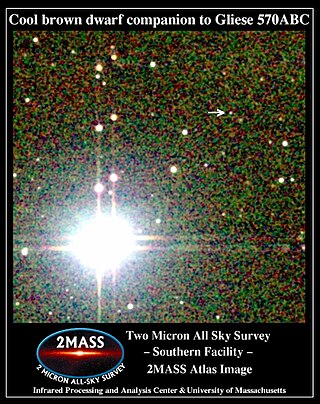Gliese 570
 The quaternary star system Gliese 570. The T-type methane brown dwarf Gliese 570D is indicated with an arrow. Credit: 2MASS | ||
| Observation data Epoch J2000.0 Equinox J2000.0 | ||
|---|---|---|
| Constellation | Libra | |
| Right ascension | 14h 57m 28.00144s[1] | |
| Declination | −21° 24′ 55.7131″[1] | |
| Apparent magnitude (V) | 5.75 / 8.07 / 10.5 | |
| Characteristics | ||
| Spectral type | K4V / M1V / M3V / T7V | |
| U−B color index | 1.06 /1.22 | |
| B−V color index | 1.11 / 1.51 | |
| Variable type | None | |
| Absolute magnitude (MV) | 6.89[3] | |
| BC | ||
Distance | approx. 19 ly (approx. 5.9 pc) | |
| Absolute magnitude (MV) | 9.19[3] / 11.05 | |
| D | ||
Distance | 19.3 ± 0.2 ly (5.91 ± 0.06 pc) | |
| Absolute magnitude (MV) | 11.05[citation needed] | |
| Details | ||
| Mass | 0.802 ± 0.040[7] / 0.55 / 0.35 / 0.05 M☉ | |
| Radius | 0.739 ± 0.019[7] / 0.65 R☉ | |
| Luminosity (bolometric) | 0.22[note 1] / 0.04 / ? / 3•10−6[8] L☉ | |
| Luminosity (visual, LV) | 0.16 / 0.02 / 0.003 / ? L☉ | |
| Temperature | 4597 ± 101[7] / 2700 K | |
| Metallicity | Rotational velocity (v sin i) | 1.50[7] km/s |
BD-20°4123, SAO 183039, LFT 1160, LPM 550 | ||
| D: 2MASS J14571496-2121477 | ||
| Database references | ||
Exoplanet Archive | data | |
| ARICNS | data | |
Gliese 570 (or 33 G. Librae) is a quaternary
Distance and visibility
In the night sky, the Gliese 570 system lies in the southwestern part of Libra. The system is southwest of Alpha Librae and northwest of Sigma Librae. In the early 1990s, the European Hipparcos mission measured the parallax of components B and C, suggesting that the system was at a distance of 24.4 light-years from the Sun. This, however, was a relatively large error as Earth-based parallax and orbit observations suggest that the two stars are actually part of a system with Gliese 570 A, and must actually lie at the same distance.
Star system
The primary star of the system (component A) is an
A binary system in their own right, components B and C are both rather dim

On January 15, 2000, astronomers announced that they had found one of the coolest
The status of Gliese 570 D as a
Search for planets
In 1998, an
See also
Notes
- Stefan–Boltzmann constant.
References
- ^ S2CID 18759600
- ^ S2CID 244398875. Gaia DR3 record for this source at VizieR.
- ^ S2CID 118577511.
- Bibcode:1967IAUS...30...57E.
- ^ S2CID 119287203.
- S2CID 18160586.
- ^ S2CID 14786643.
- S2CID 18779443
- ^ "Sixth Catalog of Orbits of Visual Binary Stars". Archived from the original on 2009-04-12. Retrieved 2008-05-18.
- ^ doi:10.1086/176149.
- S2CID 118503912.
- S2CID 19109066.
- Bibcode:2000A&A...362..585E. Archived from the originalon 2012-02-08. Retrieved 2007-08-19.
External links
- "Gliese 570 / HR 5568 ABC". SolStation. Retrieved 2008-06-12.
- Bridges, Andrew (2000-01-17). "Astronomers Unveil Hot Photo of Cool Star". SPACE.com. Archived from the original on 2008-09-05. Retrieved 2008-06-12.


![{\displaystyle {\begin{smallmatrix}\left[{\frac {Fe}{H}}\right]\ =\ 0.06\end{smallmatrix}}}](https://wikimedia.org/api/rest_v1/media/math/render/svg/1140bc04e494a2dfd4b5af2027e7b9976f913fe3)